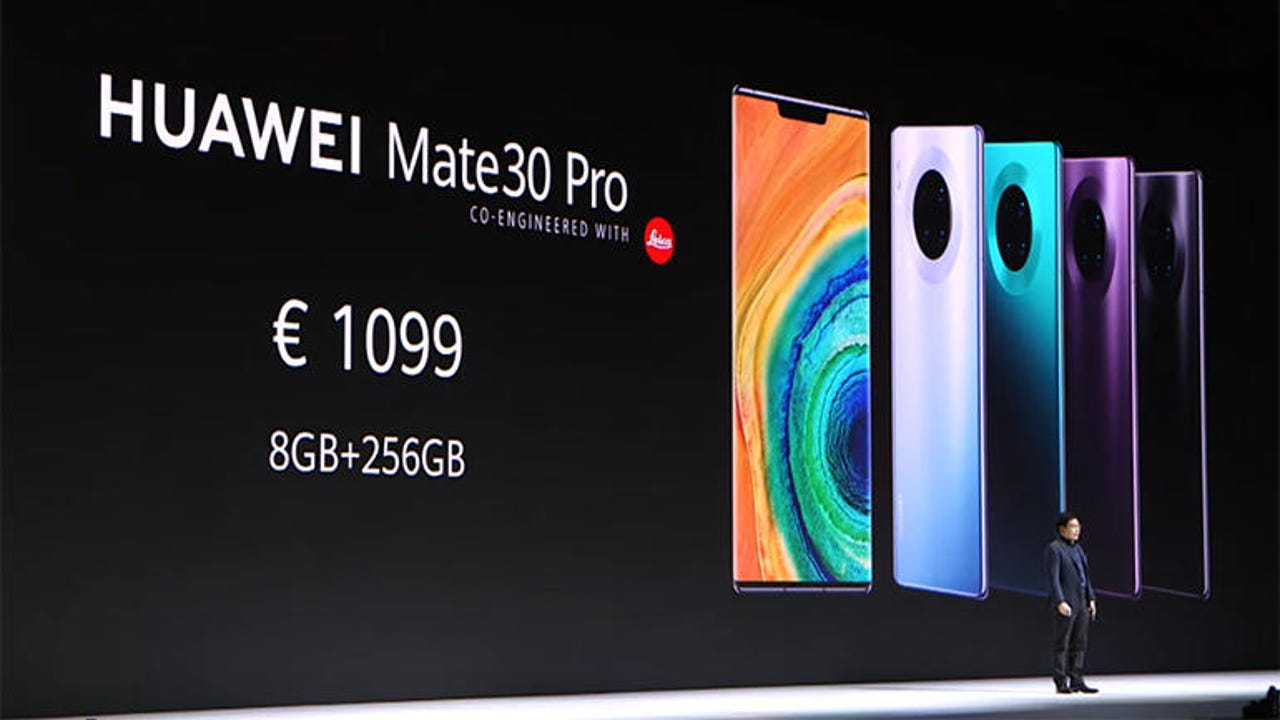Huawei unveils the Mate 30 series under a trade war cloud


Richard Yu, CEO of Huawei's Consumer Business Group, onstage in Munich on 19 September.
Under normal circumstances, the launch of Huawei's Mate 30 smartphones would be all about the design, technology, pricing and availability of new flagship devices. All these factors are still important, of course, but the current US trade war with China means that there was a rather large elephant in the room at Huawei's 19 September launch event in Munich.
Huawei
Specifically, Huawei's presence on the US Department of Commerce's Entity List means that the Mate 30 phones are shipping without Google apps and services such as the Play Store, Maps, Gmail and YouTube preinstalled. Instead, The Mate 30 Series will use Huawei Mobile Services (HMS), which includes the Huawei App Gallery. Although Huawei claims 45,000-plus apps for its App Gallery, that's a long way short of the estimated 2.7 million in Google's Play Store. To grow the HMS ecosystem, Huawei announced a $1 billion incentive program at the Munich launch event.
SEE: IT pro's guide to the evolution and impact of 5G technology (free PDF)
Although it may be possible to 'side-load' Google apps (but not the Play Store) on the Mate 30 series, the combination of the extra hassle involved and a nascent Huawei App Gallery may put all but the most determined users off. Given that Huawei phones are not officially available in the US, this leaves the company's home China market -- where Google services have long been blocked -- as the main engine for sales of its 2019 flagship handsets, which could put a dent in the company's stated ambition to become the world's number-one smartphone vendor by 2020.
So, with the elephant parked in the corner, what is Huawei offering with its Mate 30 series?
Kirin 990
Underpinning the Mate 30 series is Huawei's latest HiSilicon Kirin 990 chipset, unveiled recently at IFA in Berlin. The 7nm Kirin 990 comes in two versions, with and without an integrated 5G modem. The 5G variant supports NSA (non-standalone) and SA (standalone) 5G architectures, as well as 2G, 3G and 4G networks. According to Huawei, the Kirin 990 5G can achieve peak download speeds of 2.3Gbps in the sub-6GHz band, and peak upload speeds of 1.25Gbps.
The CPU configurations for the two chipsets are very similar: two high-frequency Arm A76 cores running at 2.86GHz, two medium-frequency A76 cores (2.36GHz for 5G variant, 2.09GHz for non-5G variant) and four power-efficient A55 cores (1.95GHz for 5G, 1.86GHz for non-5G). The GPU is a 16-core Mali-G76 module, while the NPU (Neural Processing Unit) features Huawei's own Da Vinci architecture. This uses two types of core: powerful (Big Core) and ultra-low-power (Tiny Core). The Kirin 990 5G has two Big cores and one Tiny core, while the non-5G variant has one of each type. This Big/Tiny core configuration allows Huawei to assign AI/ML tasks depending on the performance level required.
All of these advances add up to some significant performance improvements, according to Huawei:
Another key Kirin 990 component, the ISP (Image Signal Processor), delivers 15 percent better performance and benefits from BM3D noise reduction, Huawei says.
Models & specifications
Here are the key specs for the Mate 30 and Mate 30 Pro. The latter comes in 4G and 5G models, and there's also a premium Porsche Design variant.
Huawei Mate 30 | Huawei Mate 30 Pro | |
Display | 6.62 inches, Rigid OLED, 2340x1080 pixels (19.5:9, 389ppi) | 6.53 inches, Flex OLED, 2400x1136 pixels (18.4:9, 409ppi) |
Dimensions | 76.1 x 160.8 x 8.4mm | 73.1 x 158.1 x 8.8mm (9.5mm for Vegan Leather variant) |
Screen / body ratio | 87.8% | 94.2% |
Weight | 196g | 198g |
IP rating | IP53 | IP68 |
Colours | Black, Space Silver, Cosmic Purple, Emerald Green | Black, Space Silver, Cosmic Purple, Emerald Green; Orange, Forest Green (Vegan Leather) |
OS / UI overlay | Android 10 / EMUI 10 | Android 10 / EMUI 10 |
App store | Huawei App Gallery | Huawei App Gallery |
Chipset | Kirin 990 | Kirin 990 (Kirin 990 5G on 5G model) |
RAM | 8GB | 8GB |
Internal storage | 128GB | 256GB (512GB on Porsche Design model) |
External storage | Nano Memory (NM) card (in 2nd SIM slot) | Nano Memory (NM) card (in 2nd SIM slot) |
Rear cameras | 40MP (SuperSensing, f/1.8), 16MP (ultra-wide-angle, f/2.2), 8MP (3x optical telephoto, f/2.4, OIS) | 40MP (Cine, f/1.8), 40MP SuperSensing, f/1.6, OIS), 8MP (3x optical, telephoto, f/2.4, OIS), 3D Depth Sensing |
Front camera | 24MP (f/2.0) | 32MP (f/2.0), 3D Depth Sensing |
Speakers | stereo | stereo |
3.5mm audio jack | yes | no |
USB-C | yes | yes |
Wi-fi | dual-band 802.11ac | dual-band 802.11ac |
Bluetooth | 5.1 | 5.1 |
Mobile networks | 2G, 3G, 4G | 2G, 3G, 4G (+5G on 5G model) |
GPS | GPS, AGPS, Glonass, BeiDou, Galileo, QZSS | GPS, AGPS, Glonass, BeiDou, Galileo, QZSS |
NFC | yes | yes |
Infrared | yes | yes |
FM radio | no | no |
Fingerprint reader | in-screen | in-screen |
Battery | 4200mAh | 4500mAh |
Fast charging | 40W | 40W |
Wireless charging / Reverse wireless charging | 27W / yes | 27W / yes |
Price | 4G: €799 (8GB/128GB) | 4G: €1099 (8GB/256GB) |
Design
Side-touch volume control on the Mate 30 Pro.
Huawei prides itself on its industrial design, and the Mate 30 series is unlikely to disappoint on this front. The 6.53-inch Mate 30 Pro, for example, has an 88-degree curving Horizon Display that delivers almost bezel-free viewing with a 94.2% screen-to-body ratio. There's no physical volume button on the Mate 30 Pro: instead, a double tap on either side brings up an on-screen volume slider on that side -- good news for left-handers. There's no earpiece or separate fingerprint reader either, as -- like the P30 -- the Mate 30 Pro uses in-screen technology to deliver audio and fingerprint sensing.
SEE: The best cheap phones you can buy right now: Flagship features for any budget
At the back, there's a new Halo Ring arrangement for the camera lenses, designed to echo the appearance of a professional SLR camera, according to Huawei. As well as four colours, the phones are available with two shades of Vegan Leather covering to the back -- and if cost is no object, you can go for the high-spec, genuine leather-clad Porsche Design model.
Cameras
Huawei is traditionally strong in photography, with the P30 Pro riding high in the DxOMark rankings, thanks to the excellent low-light and zoom performance of its Leica-branded quad-camera system. The highlight of the Mate 30 series is the Pro model's quad camera system comprising a 40MP SuperSensing wide-angle camera with an RYYB sensor (for better low light performance), a 40MP Cine ultra-wide angle camera with a large wide-format RGGB sensor, an 8MP Telephoto camera with 3x optical zoom and a 3D Depth Sensing camera. All this enables cool imaging tricks like low-light photography with ISO 409600, 4K video at 60 frames per second (fps), ultra-slow-motion video at 7,680fps, 3x optical/5x hybrid/30x digital zoom and professional bokeh (sharp subject, blurred background) effects.
There's a notch in the screen for the front camera system, which not everyone likes, but Huawei took pains at the launch to stress the sophistication of the sensor array, which comprises a 32MP selfie camera, an ambient light and proximity sensor, a 3D depth camera and a gesture sensor.
The Mate 30 Pro's screen notch.
Batteries
Both the Mate 30 and Mate 30 Pro have large batteries (4200mAh and 4500mAh), delivering 8.2h and 9.2h respectively under a 'super heavy user profile', according to a slide at the launch presentation. Huawei's Graphene Film Cooling Technology, as seen on the 7.2-inch Mate 20 X, is used here. Fast charging at 40W, wireless charging at 27W and reverse wireless charging are all supported.
Other products launched on 19 September
The Munich event also saw the launch of Huawei's Watch GT 2 smartwatch, FreeBuds 3 wireless earphones and Huawei Vision 4K TV. Check back for more information on these devices in due course.
Outlook
These are not affordable smartphones (currently the best-selling segment of the market): the Mate 30 with 8GB of RAM and 128GB of internal storage costs €799, the Mate 30 Pro with 8GB/256GB starts at €1,099, while the no-holds barred Porsche Design model will set you back €2,095. The Mate 30 and Mate 30 Pro are both listed on Huawei's UK website, but there's currently no 'Buy' button or pricing in UK pounds.
The design and technology on offer looks superb, but it's difficult to ignore the absence of Google's apps and services, despite Huawei's sterling efforts to paper over the cracks. Let's hope for a resolution of the US-China trade war, and a resumption of normal services in the smartphone market.
RECENT AND RELATED CONTENT
Huawei Mate 30, Mate 30 Pro arrive – but without Google services
Huawei eyes AI prowess, invests in compute power
Huawei's 'new' P30 Pro ships with Android 10 despite US trade ban